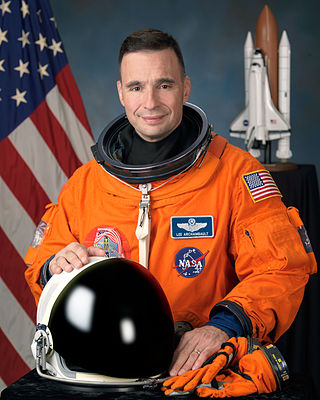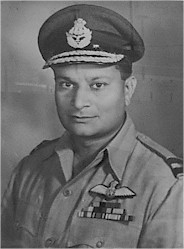
Francis Richard Scobee was an American pilot, engineer, and astronaut. He was killed while commanding the Space Shuttle Challenger in 1986, which suffered catastrophic booster failure during launch of the STS-51-L mission.

William George "Borneo" Gregory is an American retired NASA astronaut and United States Air Force lieutenant colonel.

Steven Wayne Lindsey is a retired U.S. Air Force officer and NASA astronaut. Lindsey served as Chief of the NASA Astronaut Office from September 2006 until October 2009.

James McNeal "Vegas" Kelly is a NASA astronaut and a retired Colonel of the United States Air Force. He twice served as pilot on Space Shuttle missions. James Kelly is not related to Scott Kelly or Mark Kelly.

Indian Space Research Organisation is the national space agency of India. It operates as the primary research and development arm of the Department of Space (DoS), which is directly overseen by the Prime Minister of India while the Chairman of ISRO also acts as the executive of DoS.

Lee Joseph "Bru" Archambault is an American test pilot and former NASA astronaut. He has logged over 4,250 flight hours in more than 30 different aircraft. Archambault is married with three children. His hobbies include bicycling, weightlifting, and playing ice hockey. Archambault has received numerous awards and honors throughout his life. He has also flown two Space Shuttle missions, as pilot of STS-117 in 2007 and as commander of STS-119 in 2009. Archambault left NASA in 2013 after a 15-year career with the agency in order to become a test pilot for Sierra Nevada Corporation on their Dream Chaser orbital spaceplane project.

The Indian Human Spaceflight Programme is an ongoing programme by the Indian Space Research Organisation (ISRO) to develop the technology needed to launch crewed orbital spacecraft into low Earth orbit. Three uncrewed flights, named Gaganyaan-1, Gaganyaan-2 and Gaganyaan-3 are scheduled to launch in 2024, followed by crewed flight in 2024 on an HLVM3 rocket.
Human-rating certification, also known as man-rating or crew-rating, is the certification of a spacecraft or launch vehicle as capable of safely transporting humans. There is no one particular standard for human-rating a spacecraft or launch vehicle, and the various entities that launch or plan to launch such spacecraft specify requirements for their particular systems to be human-rated.

Gaganyaan is an Indian crewed orbital spacecraft intended to be the formative spacecraft of the Indian Human Spaceflight Programme. The spacecraft is being designed to carry three people, and a planned upgraded version will be equipped with rendezvous and docking capabilities. In its maiden crewed mission, the Indian Space Research Organisation (ISRO)'s largely autonomous 5.3-metric ton capsule will orbit the Earth at 400 km altitude for up to seven days with a two- or three-person crew on board. The first crewed mission was originally planned to be launched on ISRO's HLVM3 rocket in December 2021. As of October 2023, it is expected to be launched by 2025.

Lena Mohan Kumar, known by stage name Lenaa, is an Indian actress, author, and scriptwriter who appears predominantly in Malayalam cinema. In a career that spans over 25 years, Lenaa has worked in over 175 films in 5 languages, including blockbusters as well as critically acclaimed films in English, Hindi, Tamil, Telugu, and Malayalam.
The Indian Air Force has been undergoing a modernization program to replace and upgrade outdated equipment since the late 1990s to meet modern standards. For that reason, it has started procuring and developing aircraft, weapons, associated technologies, and infrastructures. Some of these programs date back to the late 1980s. The primary focus of current modernization and upgrades is to replace aircraft purchased from the Soviet Union that currently form the backbone of the Air Force.
Tactics and Air Combat Development Establishment or TACDE is an Indian Air Force unit for training aerial combat to its top one percent fighter pilots. TACDE is based in Gwalior, Madhya Pradesh. It was conferred Presidential standard in 2009. The institution evolves tactical procedures for various aircraft, implements standard operating procedures and trains pilots in operational doctrines.
Dr.V. R. Lalithambika is an Indian engineer and scientist who has been working with the Indian Space Research Organisation (ISRO). She is a specialist in Advanced Launcher Technologies and was leading the Gaganyaan mission to send Indian astronauts to space by 2022.

The Human Space Flight Centre (HSFC) is a body under the Indian Space Research Organisation (ISRO) to coordinate the Indian Human Spaceflight Programme. The agency will be responsible for implementation of the Gaganyaan project. The first crewed flight is planned for 2024 on a home-grown LVM3 rocket.

Vyommitra is a female-looking spacefaring humanoid robot developed by the Indian Space Research Organisation to function on-board the Gaganyaan, a crewed orbital spacecraft. Vyommitra was first unveiled on 22 January 2020 at the Human Spaceflight and Exploration Symposium in Bengaluru.
Gaganyaan-1 will be the first uncrewed test flight of the Gaganyaan programme, with launch planned for July 2024.

The Indian Orbital Space Station, officially called, Bharatiya Antariksha Station, is a planned modular space station to be constructed by India and operated by the Indian Space Research Organisation (ISRO). The space station would weigh 20 tonnes and maintain an orbit of approximately 400 kilometres above the Earth, where astronauts could stay for 15–20 days. Originally planned to be completed by 2030, it was later postponed to 2035 due to delays caused by technical issues related with the Gaganyaan crewed spaceflight mission and the COVID-19 pandemic in India. As of December 2023, the first module is expected to be launched in 2028 on an LVM3 launch vehicle, with the remaining modules to be launched by 2035 on the Next Generation Launch Vehicle.

Air Vice Marshal Ranjan Dutt, VrC was a former air officer of the Indian Air Force. He last served as the Air Officer Commanding-in-Chief Eastern Air Command. Prior to that, he was the managing director of Hindustan Aeronautics Limited.

Gaganyaan-4 will be the first crewed test flight of the Gaganyaan programme, with launch planned for 2025.














